External links:
Notes:
Introduction
Europe, 1347. A disaster is about to strike. The black death reaches Europe,
and during the next 4 - 5 years, the population of Europe will be halved. The players
settle in the various regions of Europe, while the plague spreads throughout all
of the continent. The players gain help from the various classes of the middle ages:
The peasants provide population growth, the wise monks keep the rats
away, the rich merchants flee when the plague approaches, the warfare conducted
by the knights spreads the plague to new areas, the witches control
the spread through magic and witchcraft, whereas the kings avoid the plague
by staying in their fortified palaces. But the plague does not make any distinction:
When the rats arrive, no one can feel safe. When the plague withdraws and the game
ends, the player with the highest surviving population wins.
Game components
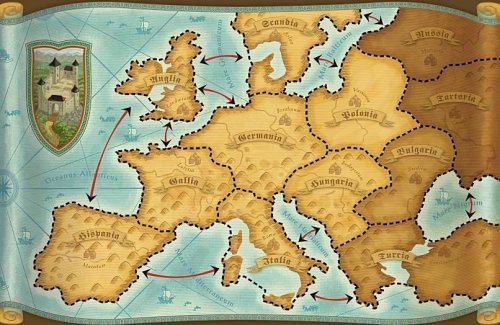
|
2 player:
3 player:
4 player:
|
Anglia
Gallia
Germania
Hispania
Hungaria
Italia
Polonia
Scandia
Bulgaria
Turcia
Russia
Tartaria
|
The game board depicts Europe in the middle ages, divided into 12 regions.
Arrows indicate regions that are treated as neighbours, even though they have no
common border.
- In 2 player games use the light coloured regions only.
- In 3 player games use the light and middle coloured regions.
- In 4 player games use all regions on the board.
|
6 class cards
|
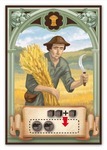
|
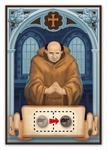
|
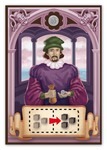
|
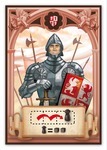
|
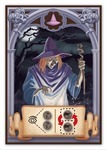
|
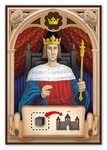
|
| Peasant
|
Monk
|
Merchant
|
Knight
|
Witch
|
King
|



 80 small cubes (20 in each of the four player colours).
80 small cubes (20 in each of the four player colours).


|
49 rat tokens, showing a rat on the back and a plague event on the front.
|


|
12 of these are marked with a purple circle, these are the starting rats
to be used when setting up the game.
|

|
1 plague piece
|
Preparations
1.) The game board is laid out on the table. The six class cards are
laid out beside it.
2.) Each player chooses a colour and receives all the cubes of this
colour.
3.) The twelve starting rat tokens (the ones marked with purple circles)
are mixed (face down), and one rat token is placed in each region of the board (still
face down). In a 2/3-player game, only 8/10 regions are used, thus only 8/10 starting
rats are placed on the board.
4.) The regular rat tokens are mixed (face down) and kept as a supply
beside the board. With less than 4 players, some randomly drawn rat tokens (not
the starting rats) are removed (unseen) from the game: With 2 players, remove 12
rat tokens. With 3 players, remove 6 rat tokens. The remaining starting rat tokens
are mixed together with the regular rats.
5.) The plague piece is placed in a randomly chosen region.
6.) The youngest player starts the game. Starting with him and going clockwise
around the table, each player places two of his cubes in any region on the board.
Thereafter, starting with the last player and going anti-clockwise around the table,
each player places two more of his cubes in any region on the board.
7.) Thereafter, the starting player makes the first turn, and the other players
follow clockwise around the table.
Game play
The player on turn plays through the following phases:
A Pick a new class card (optional)
B Place new cubes on the board
C Move the plague piece
Phase A and B may be done in any order, but phase C (moving the plague piece) must
always be done at the end of the turn.
A Pick a new class card (optional)
The player may take one class card, either one of the untaken ones beside the board
or from another player. The class cards taken by the players are kept clearly visibly
on the table in front of each player. Each of the six cards yield certain advantages
to the player owning them (these will be explained later), but at the same time
they increase the probability of the cubes of the player being killed by the plague.
The player must keep his class cards until they are taken away by another player,
once taken there is no other way of getting rid of them.
Even if the player already has one or more class cards on the table in front of
him, he is allowed to take another card during each of his turns. Thus it may often
happen that one player has more than one card at the same time, in this case he
gains all the advantages of all the cards he has.
B Place new cubes on the board
The player may place cubes of his own colour in any one region on the board. He
places as many cubes as the number of rat tokens currently present in the chosen
region. Thus, the player may not add any cubes to a region with no rat tokens (exception:
the card Peasant, see below).
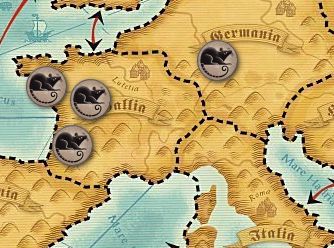
|
Example: There are currently three rat tokens in Gallia, one in Germania
and none in Italia. It is the red player's turn. He chooses to add one of his cubes
to Germania. If he instead decided to add cubes to Gallia, he would be allowed to
add three cubes, while in Italia he would not be allowed to add any cubes at all.
|
C Move the plague piece
Finally, the player must move the plague piece. The plague piece must be moved to
a neighbouring region of its current location. The player on turn chooses freely
among the neighbouring regions, but he is not allowed to let the plague piece remain
in its current region. In the following, the region moved to by the plague piece
is called the plague region.
Thereafter, the plague ravages
1.) First, the plague spreads.
-
If the plague region contains no rat tokens, nothing happens.
-
If the plague region contains one rat token, the player on turn places a new rat
token from the supply in any region neighbouring the plague region.
-
If the plague region contains two or three rat tokens, the player on turn places
TWO new rat tokens from the supply in any region(s) neighbouring the plague region
(either two rats in one region or one rat in each of two different regions).
2.) The plague ravages the plague region.
If the plague region contains at least one cube and one or more rat tokens, these
rat tokens are revealed and evaluated one at a time, until either all rat tokens
have been revealed or all the cubes in the region have been removed. All revealed
rat tokens are removed from the game, any remaining face-down rat tokens remain
in the region.
Note: The rat tokens must be placed face down, no players are allowed to
look at the front sides!
Note: There may never be more than three rat tokens at the same time in any
one region! Therefore it is not allowed to add rats in a region already containing
three rats. In this case the player has to choose another of the regions neighbouring
the plague region. In the rare event that all the neighbouring regions of the Plage
region contain three rats, no more rats are added.
The front sides of all the rat tokens show two kinds of information
|
A limit value. If the total number of cubes (regardless of colours) in the
plague region is equal to or greater than the given limit value, the plague will
now have an outbreak. Otherwise, that is, if the number of cubes is lower than the
given limit value, the rat token is removed from the game without any further consequences.
|


|
One or more symbols. These symbols indicate which of the classes that are
infected by the plague. For each given class symbol, the player currently owning
the corresponding class card has to remove one of his cubes from the plague region
and put it back into his supply. If the player does not have any cubes in this region,
he is not affected.
|
In addition to or instead of class symbols, the symbols
 (Majority) or
(Majority) or
 (All) may also appear.
(All) may also appear.
For each given M, the player currently having most cubes of his colour in
the plague region has to remove one cube. In the case of a tie for majority, all
tied players have to remove one cube each. The M symbols are always evaluated first,
that is, they always affect the player who has the majority of cubes in the region
when the rat token is revealed, even if other symbols on the rat token would result
in another player having more cubes than this player.
For each given A, all players with cubes in the plague region have to remove
one cube each.
As soon as the plague region either contains no more rat tokens or no more cubes,
the current turn ends, and the next player begins his turn.
Example
The yellow player currently has the card
knight (chivalry), the green player has
the cards peasant (peasantry) and merchant (bourgeoisie), and the blue player has the monk (church), witch (magic) and king (royalty).

It's the red player's turn, and he is about
to enter phase 3 (move the plague Piece). He decides to move the plague piece into
Gallia. Gallia currently contains three rat tokens, two green cubes and one yellow
cube. First, the plague spreads. Since Gallia contains three rat tokens, two new
rat tokens have to be placed in one or two of the neigbouring regions of Gallia.
The red player choosed to place them both in Hispania. Thereafter, the plague ravages
Gallia. One by one, the three rat tokens are revealed:
1.) The first revealed token shows the limit value 1. Gallia contains three
cubes, therefore the plague will have an outbreak. The rat token shows one bourgeoisie
symbol and one church symbol. Since the green player currently has the merchant
(bourgeoisie) card, he has to remove one of his cubes and return it to his supply.
The blue player has the monk (church) card, but since he does not have any cubes
in Gallia, he obviously does not have to remove any.
2.) Since Gallia still contains more cubes, the next rat token is revealed.
It has the limit value 3. However, currently Gallia only contains two cubes (since
one of the green ones was just removed), therefore this rat token has no effect.
3.) Finally the last rat token is revealed. It turns out to have a limit
value of 2, therefore the plague once again has an outbreak. The symbols given on
this rat token are M (majority), bourgeoisie and church. The green and yellow player
are currently tied for the majority, therefore they both have to remove one cube
each.

Consequently, Gallia is now completely devastated. According to this last rat token,
the player holding the bourgeoisie card (green) and the player holding the church
card (blue) should remove one cube each from the region, however, neither of them
have any cubes in Gallia to remove.
The class cards
Note: Only the player whose turn it is may use the special abilities of his
class card(s). He may use the abilities of each card only once each turn , and only
before phase C is played (exception: knight).
 Peasant Peasant
|
A player holding this card may add one cube more than usual when he adds
cubes to a region in phase B (place new cubes on the board). For example, he may
add 4 cubes to a region containing 3 rat tokens, or 1 cube to a region without rat
tokens.
|
 Monk Monk
|
A player holding this card may, at any time on his turn, move any one rat token
from any region to a neighbouring region. This movement may be performed
either before or after adding new cubes in phase B.
Example: A region contains 3 rat tokens. The player on turn may add 3 cubes
into this region. If he holds the monk card, he may thereafter move one of the rats
into a neighbouring region.
Note: No region is ever allowed to contain more than 3 rat tokens. Therefore
a player holding the monk may not move a rat into a region already containing 3
rats.
|
 Merchant Merchant
|
A player holding this card may, at any time on his turn, move up to 3 cubes of his
own colour from one region to one of its neighbouring regions.
|
 Knight Knight
|
A player holding this card may move the plague piece up to two steps in phase
C, before the effects of the plague are evaluated. Additionally, the player may,
before the rat tokens are revealed, decide to let the plague piece count as two
neutral population cubes in the affected region for the purpose of evaluating the
population limits on the rat tokens.
Example: If the plague piece is in Italia, the player may for example move
it to Scandia, if he holds the knight card. If the player chooses to let the plague
piece count as two extra cubes, and Scandia contains two cubes, the plague will
have an outbreak even if a rat with a limit value of 3 or 4 is revealed.
|
 Witch Witch
|
A player holding this card may, at any time on his turn, look at any one
rat token on the board. Thereafter, he may look at any other rat token on the board,
either in the same or in a different region. Finally, he may, if he wishes, swap
the two selected rat tokens (this obviously only makes sense if he looked at rat
tokens in two different regions).
|
 King King
|
A player holding this card may, at any time during his turn, move one of his cubes
on the board to the palace area. This cube must be taken from a region containing
no rats. Cubes in the palace area are safe for the rest of the game, and count as
regular cubes when counting score at the end of the game.
|
Game end
The game ends after the turn during which either
- the supply of rat tokes is depleted, or
- a player manages to have all his cubes on the board at the end of his turn (this
is rare).
Thereafter a final round follows, in which all players, except the player having
the last regular turn, may use the abilities of their class cards one last time.
- This final round is played anticlockwise, beginning with the player sitting right
of the player who had the last regular turn.
- In this final round the players are only allowed to use the abilities of the cards
they currently hold.
- They are neither allowed to take any new cards,
- add cubes (exception: peasant)
- nor move the plague piece (exception: knight).
Peasant: A player holding this card may add a cube of his own colour in any
one region.
Knight: A player holding this card may move the plague piece up to two steps.
When the game ends, the plague piece counts as usual as two neutral population cubes
in the affected region.
Finally, the plague ravages all the 12 regions, that is, one at a time all the rat
tokens are revealed and evaluated. After this, the player with the most cubes still
in play on the board (including any cubes in the palace area) wins. In the case
of a tie between two or more players, the game is won by the player (among the tied
players) that would have had the next turn if the game had not ended.
Europe, 1348. The Black Death ravages Europe. Until now the players have used
the help of a handful of different medieval classes to fight the plague. Now it’s
time to call for reinforcements. 12 new personalities are ready to provide their help
to the players. Some of these, like the Queen and the Emperor, use their wealth and power
to aid the players. Some, like the Nun and the Bishop, use wisdom and faith to avoid the
plague, while others resort to magic and witchcraft, like Pied Piper, who uses his
magical flute to lure the rats along with him.
Game Components
-
12 Class Cards
(2 for each of the 6 classes Peasantry, Bourgeoisie, Church, Chivalry, Magic and Royalty)
-
2 bishop pieces


-
3 nun pieces



-
3 wall pieces



-
10 potion tokens










Preparations and Game Play
This expansion contains two extra class cards for each class. Including the class cards from the base game,
there are now three different cards for each class, for a total of 18 cards. However, in each game only 6
of these cards are used. After selecting which class cards to use, the game is prepared as in the rules for
the base game. Some of the class cards in this expansion require additional materials (Bishop: bishop pieces,
Emperor: wall pieces, Nun: nun pieces, and Wizard: potion tokens). If any of these class cards are to be
used in the game, the corresponding additional material is placed next to the board. Before the game starts,
the 6 class cards that will be used in the game are selected.
This can be done in a different number of ways:
- Draw 6 cards at random after shuffling all 18 cards.
- Shuffle the cards of the 6 different classes separately, then draw one at random for each class.
- Use one of the suggested sets listed at the end of this rulebook.
- Select a set of cards that all players agree on.
Note: When playing with less than 4 players, it is recommended that at least one of the Chivalry cards
is included among the class cards used, to ensure that no part of the board will ever be completely safe from the plague.
The game is played according to the regular rules from the base game, using the six selected class cards.
If two or more cards belonging to the same class are in play, each symbol on a rat token will kill one cube for
each card of this class a player holds.
Example: If both the Crusader card and the Knight card are in play, and two different players hold these
cards, they will lose one cube each for each Chivalry symbol when the plague has an outbreak. If both these cards
are held by one player, this player will lose two cubes for each Chivalry symbol.
The New Class Cards
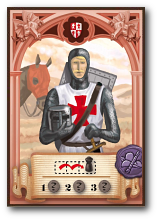 Crusader Crusader
|
A player holding this card may move the Plague Piece up to two steps in phase C, before the effects of
the plague are evaluated. Additionally, the player may reveal all the rat tokens in the Plague Region
simultaneously, and then decide the order in which they will affect the Plague Region.
|
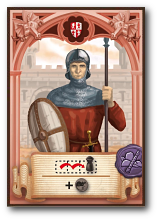 Soldier Soldier
|
A player holding this card may move the Plague Piece up to two steps in phase C, before the effects
of the plague are evaluated. Additionally, when placing new rats in phase C, he may place one extra
rat.
Card Combinations: If a player holds two or more Chivalry cards, he will still only be able to move
the Plague Piece up to two steps.
|
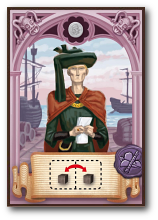 Courier Courier
|
A player holding this card may swap any two cubes on the board. That is, he may swap one of his own
cubes with a cube belonging to another player in another region, or he may swap two cubes belonging
to two other players.
Note: The swapping performed by the Courier is not affected by any wall pieces in play.
|
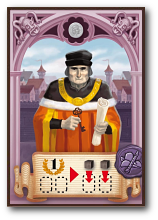 Mayor Mayor
|
A player holding this card may, instead of adding cubes according to the regular rules (one cube per rat)
in phase B, add one cube to each region in which he has more cubes of his color than any other player.
Card Combinations: If the player additionally holds the Peasant card, the extra cube may be placed in
one of the regions in which he has more cubes of his color than any other player. If the player additionally
holds, and is able to use, the Queen card, the two extra cubes may be placed in one or two of the regions in
which he has more cubes of his color than any other player.
Note: He can choose not to use the ability of the Mayor; if he prefers to he may place according to the
number of rats instead.
|
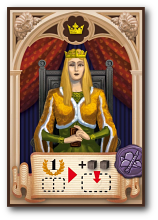 Queen Queen
|
If the player holding this card has cubes of his color in a larger connected area than any other player, he may
add two cubes more than usual when he adds cubes to a region in phase B ("Place new cubes on the board").
Example: Currently, there are red cubes in Anglia, Gallia and Hispania, blue cubes in Russia and Tartaria,
yellow cubes in Hispania, Italia and Polonia, and green cubes in Germania and Turcia. Thus, the largest connected
area of the red player contains 3 regions, the blue and yellow players both have 2 connected regions, while the largest
connected area of the green player only contains 1 region. Therefore, if the red player holds the Queen card, he may
add two extra cubes when placing cubes. If any other player holds the Queen card, they would not be able to use the
advantage of the Queen card in this situation.
|
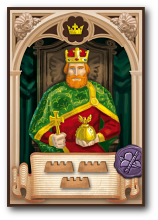 Emperor Emperor
|
A player holding this card may place (or move, if already in play) the three wall pieces. A wall piece
may be placed on a border between two regions on the board, or on an arrow connecting two regions. Nothing
can be moved across a border blocked by a wall piece, that is, neither rats, cubes nor the Plague Piece may
cross this border until the wall is taken away.
Note: The nun and bishop pieces (see below) are not blocked by the walls, since these are placed
freely on the board and not moved between regions.
|
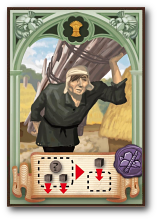 Serf Serf
|
In phase C of his turn, a player holding this card may place one cube of his own color into the plague region
for each rat token that kills at least one cube belonging to another player. The cube is placed in the region
immediately, and may thus affect (and be affected by) the resolution of the remaining rat token(s).
|
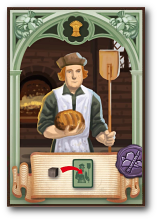 Baker Baker
|
A player holding this card may place one cube of his own color on the Baker class card on each of his
turns. Whenever the Baker class card is taken by another player, that player immediately places all the cubes
on the card in a region of his choice on the board.
|
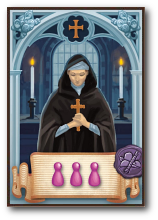 Nun Nun
|
A player holding this card may place (or move, if already in play) the three nun pieces. A nun piece
may be placed in any region, and several nun pieces may be placed in the same region. Each nun piece reduces
the population of the region by one for the purpose of evaluating the population limits on the rat tokens in phase C.
Example: Scandia currently contains three cubes and two nuns. The plague will only have an outbreak if a rat
token with a limit value of 1 is revealed.
|
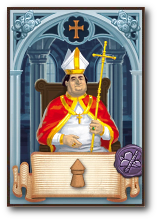 Bishop Bishop
|
A player holding this card may place (or move, if both are already in play) one of the two bishop pieces.
A bishop piece may be placed in any region, and both bishops may be located in the same region. The bishop protects
the region against rats: No rats may in any way be moved into or placed in a region containing one or both bishop pieces.
|
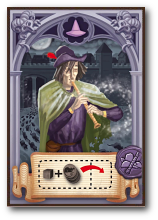 Pied Piper Pied Piper
|
A player holding this card may move one cube of his own color from one region into a neighboring region.
If he does this, he has to move along as many rat tokens as possible from the original region into the new
region. The wall pieces prevent such movement. If a player uses Pied Piper to move a cube into a region containing
a bishop piece, no rat tokens are moved along into the new region.
Note: The regular rule limiting the number of rats per region to three still applies. Thus, if a player moves a
cube from one region into a neighboring region containing two rats, he only moves along one rat into the new
region. The player is allowed to use Pied Piper to move a cube into a neighboring region even if no rats can be moved
along, that is, if the original region contains no rat and/or if the new region already contains three rats or a bishop
piece.
|
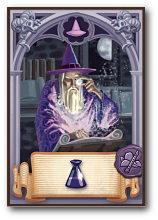 Wizard Wizard
|
A player holding this card may place one potion token with one of the cubes of his color anywhere on the board. A
cube can possess more than one potion token. A potion token protects the cube it is placed with: Whenever a cube
must be removed due to a plague outbreak in phase C, the owner of the cube may instead choose to remove a potion token
placed with the cube.
Note: Removing a potion token in this way does not count as the rat killing a cube for the purpose of using
the advantage of the Serf card.
|
Game End
As in the base game, when the game ends there is a final counter-clockwise round in which all players, except the player
having the last regular turn, may use the abilities of their class cards one last time. After the final round, and before
the plague ravages all the 12 regions, if the Baker card is in play the player to the left of the player currently holding
the Baker card places all the cubes on the card in a region of his choice on the board.
In the final round, the cards have their usual abilities, with the following exceptions:
-
Queen: If the condition of the Queen card is fulfilled, the player may add two cubes to any region.
- Soldier: The player may add one rat into a neighboring region to the Plague Piece. If the supply of rat
tokens is empty (as it usually is when the game ends), draw at random from the used rat tokens.
- Crusader: The player may move the Plague Piece up to two steps, reveal all the rats in this region and
immediately resolve them in any order he chooses.
- Serf: The player may move the Plague Piece one step, and let the card affect the region moved into.
- Mayor: The player may add one cube to one region in which he has more cubes than any other player.
- Card Combination: If one player holds more than one of the cards that depend on the Plague Piece (Crusader,
Knight, Serf), he must apply the effects of these cards in the same region.
Suggestions for card sets
- Prosperous times: Peasant, Baker, Serf, Queen, Mayor and
Soldier. This set contains mostly cards that allow players to add extra cubes. Therefore, the board will
tend to become more populated than usual.
- Rat Control: Pied Piper, Wizard, Bishop, Nun,
Monk and Emperor. This set consists of cards that affect movement, placement or the resolution of rats.
- Europe at War: Knight, Crusader, Soldier, Courier, Merchant and Pied Piper.
This set contains cards that allow the players to attack each other in various ways.
Rules changes + Notes:
- General: The final plague phase is performed automatically by the system.
The order of the resolved regions is always the same; the order of the resolved
rat tokens of a region is determined at random. Once the final plague phase has
started, the move cannot be reset any more.
-
King: If a player has both normal cubes and cubes with potions in the region, a cube without potion will be moved
into the castle. If all cubes have potions, a cube with the lowest number of potions will be moved into the castle.
(That cube’s potion(s) will be removed since in the castle they are not necessary any longer.)
-
Witch: Whenever a player reveals rat tokens by using the Witch action, those cubes will stay open for that player
as long as they are not removed from the board (Phase C). They also stay open if they are moved by Monk, for example.
Note: The rat tokens mentioned above are not revealed in
games that had been created before the Pied Piper Update went online.
-
Courier: The program will allow swapping cubes that belong to the same player. Obviously, this would only make sense,
if one of the cubes has potions, the other one not, for example.
-
Wizard:
In order to avoid out-of-turn action, this card works as follows:
If a cube must be removed because of the rat token evaluation in Phase C, a potion will always be removed whenever a cube of that
colour with potions allocated is available. If there are more cubes with potions, the potions will be removed from the cube that
has a higher number of potions allocated.
Note: On Yucata, the potion tokens are not limited, i.e. the
Wizard action can always be performed, even if 10 potions have already been placed on the board (and not been removed yet).
-
Knight, Crusader, Serf: If a player plays these cards in the last round, the Plague phase will be performed immediately after the
plague piece has been moved into the region. It is possible to combine these cards but they have to be used in one region (as written in
the rules). You have to click only one card but you will be asked if you want to use the other cards
(if possible).
-
Soldier: If this card in played in the last round and the stock of rat tokens is depleted, one rat token of all rat tokens of the game
will be drawn at random. This means, that it is possible that the rat that has been drawn is a rat that had not been used in the actual game
before.